Home Safety Checklist For State College
Staying safe and secure in your house should be your number one concern. But are you forgetting a few big safety items? Take this home safety checklist for State College and discover where your living space requires greater attention.
We give you five whole-home safety ideas, and then we break it down on a room level. Then, call (814) 212-8021 or send in the form below for more information.
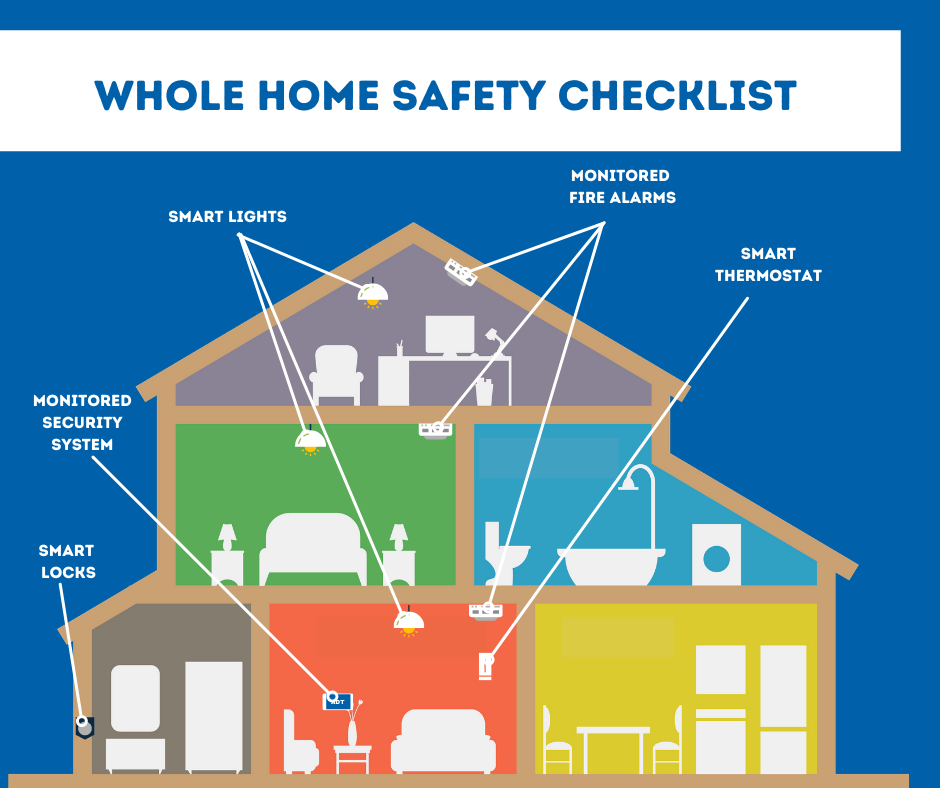
General Home Safety Checklist for State College
While you will want to take a room-by-room approach to home safety, there are some things that work for the entire house approach. These components can talk to each other through a smart hub, and often can work off one another. You can also manage every one of your home safety devices using a mobile app, such as ADT Control:
-
Monitored Security System: All your doors and windows should use a sensor that alerts you and your family to intrusion. When your alarm goes off, your monitoring team picks up the alert and immediately sends emergency personnel.
-
Smart Bulbs For Each Room: Of course, you can program your smart lighting to become more efficient. But they can also allow you to keep safe throughout an emergency. Have your lights flash on when a security alarm goes off to scare off robbers or illuminate a path to a safe area.
-
Smart Thermostat: Likewise, a smart thermostat in State College could save you up to 15% in gas and electric spending. Also, it can flip on an exhaust fan if you have a fire.
-
Monitored Fire Detectors: At the very least, you need to have a smoke detector on every level. You can increase your fire game by installing a monitored fire detector that looks for both heat and smoke, and alerts your round-the-clock monitoring experts when it detects a fire.
-
Smart Door Locks: Every entryway that uses a keyed lock can upgrade to a smart door lock. Now you can program codes to each family member and get notifications to your phone when your locks are activated. Your locks can even automatically unlock, allowing you to quickly get out during a fire or dangerous situation.
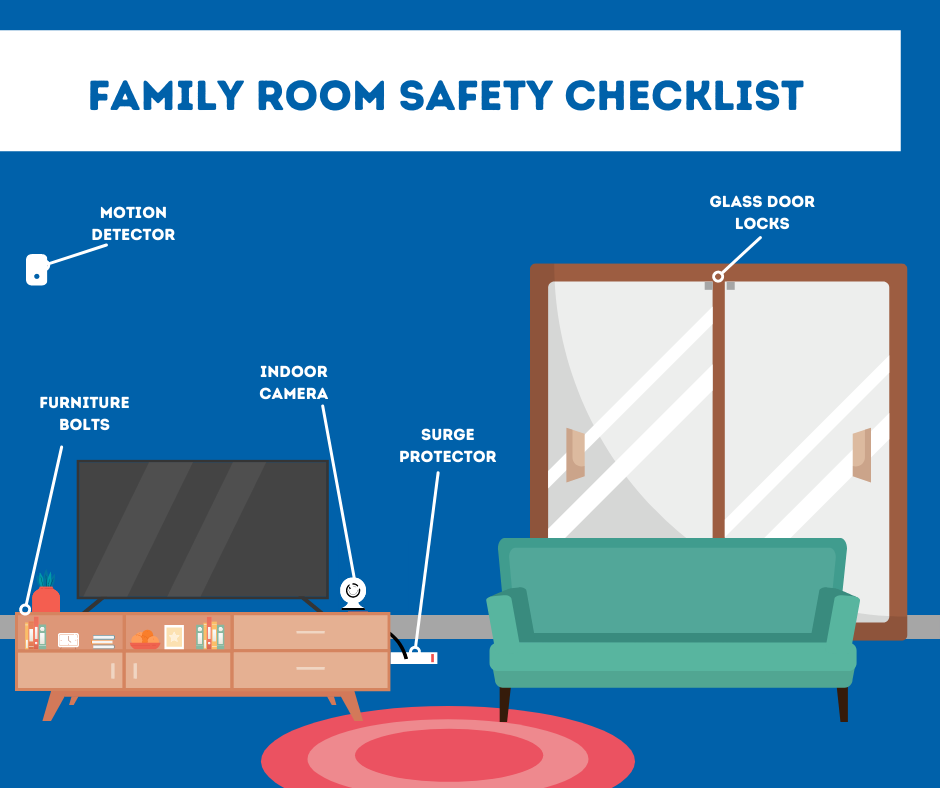
Living Room/Family Room Safety Checklist For State College
You’ll spend most of your time in the living room, so it’s the most reasonable room to improve your home safety. Electronics, like a big screen or stereo system, probably are located in your family room, making it a popular area for burglars. Start with placing a motion sensor or security camera by the doorway, then try some of these safety protocols:
-
Motion Detectors: By hanging motion sensors, you’ll get a loud noise whenever they sense suspicious movement in your family room. The best devices are motion detectors that filter out pet movements or you’ll see an alert each time your dog roams by for a drink of water.
-
Security Camera: An indoor security camera offers an eye on your family room. Watch constant streams of the area so you can find out what’s going on without leaving your bed. Or talk with your family in the living room using the two-way talk feature.
-
Surge Protector/Cord Maintenance: Protect all your electronics and quit overloading your circuits with a surge protector. For added convenience, set up a smart plug with surge protection in the unit.
-
Furniture Attached To The Wall: If you have curious kids, you’ll need to bolt your heavy furniture and entertainment center to a wall. This is especially important if your living room has carpeting that can make furniture extra wobbly.
-
Enhanced Locks For Sliding Doors: If your living room has a sliding door that slides out to a patio, deck, or screened-in porch, you probably get that the door lock is fairly worthless. Put in an enhanced lock, like a cross bar or small locks that are located on the top and bottom of the frame.
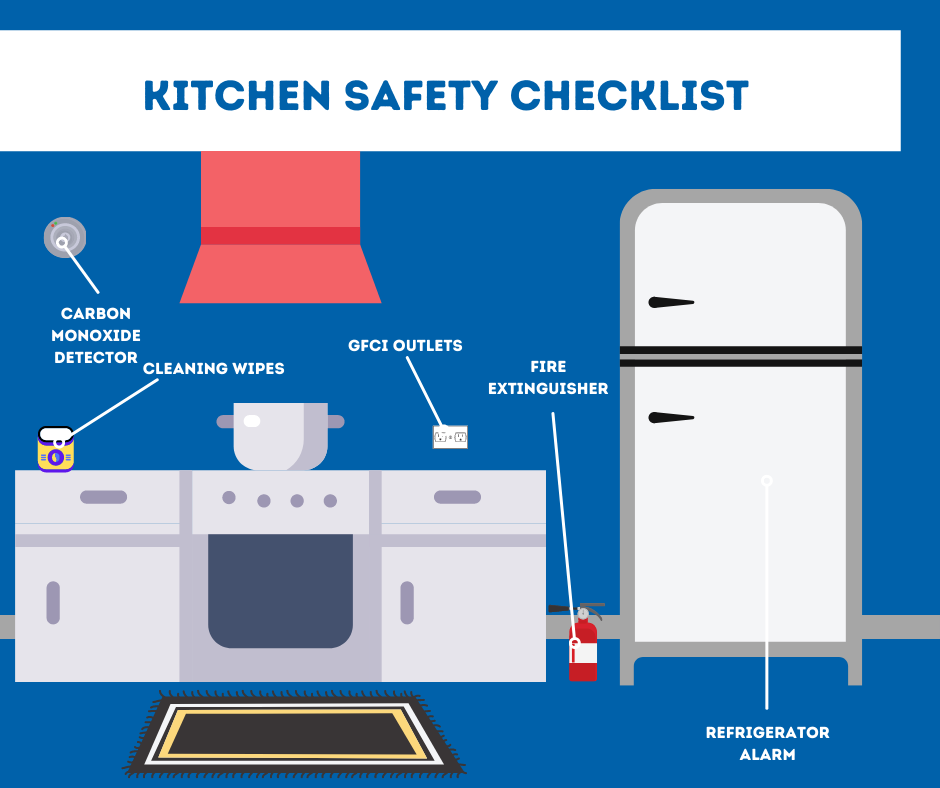
Kitchen Safety Checklist For State College
The kitchen has plenty of items that can bring comfort and safety to your home. Some of these objects are also easy to add and should be purchased from the grocery store:
-
Fire Extinguisher: Fire can come from from an unwatched skillet or an errant grease splatter. Always have a fire extinguisher at the ready for any cooking mishaps.
-
Circuit Interrupter Box On Each Outlet: A circuit interrupter outlet should be installed on outlets where they’re by water to ward off electrocution. That means the plug outlets around your sink and kitchen counter. Since 1987, it’s been code to have one circuit interrupter outlet per circuit. But all your plugs will go dead if any outlet sees a surge, so try to use a separate GFCI on each outlet.
-
Monitored CO Detector: A CO detector is advised for spaces that use natural gas for the oven and stove. If your gas lines leak, the CO detector will cause a high-decibel noise and contact your monitoring expert.
-
Cleaning Wipes Or Spray: The most overlooked safety issue in the kitchen is the invisible bacteria and cross-contamination that comes with uncooked meat and dairy. Always keep antiviral wipes or spray to scrub off your surfaces when cooking.
-
Refrigerator/Freezer Alarm: The items in the fridge should stay at a chilly temperature to be healthy to consume. If you accidently leave the refrigerator door open too long, then a small beep will tell you to close the door. Some fridges already have a pre-installed alarm, some do not, and you’ll have to pick up a fridge alarm from the hardware store.
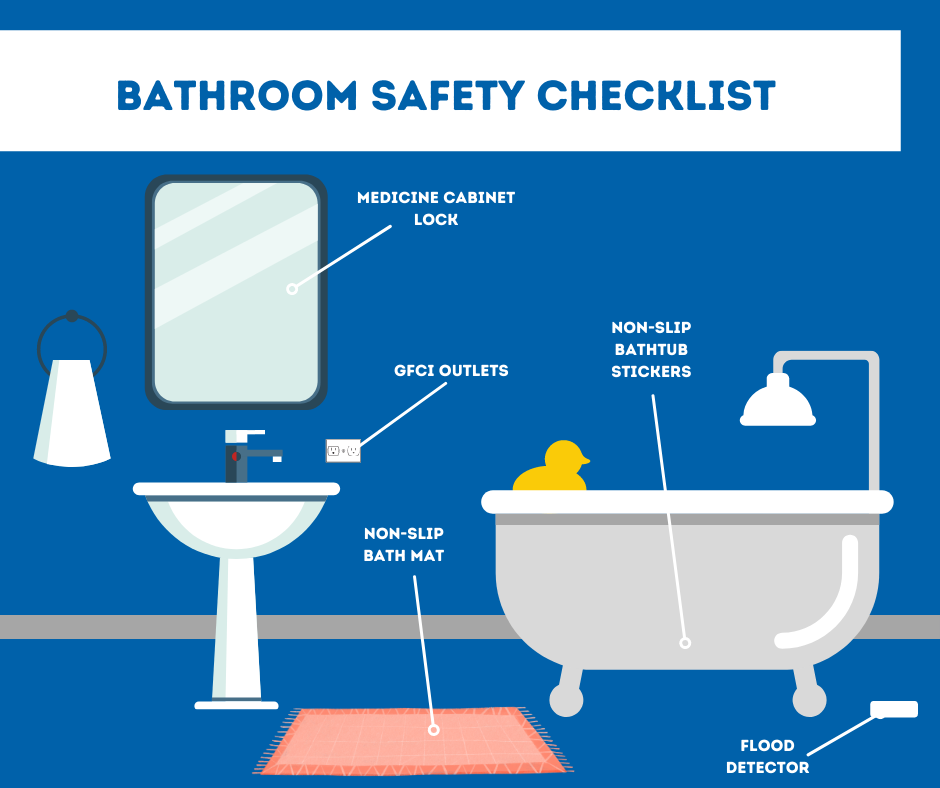
Bathroom Safety Checklist For State College
Just because there’s not a bunch of space in your bathroom there’s still safety issues. From flood detectors to anti-surge outlets, here are some safety tips for your bathroom:
-
Flood Sensors: A leaking toilet or bathtub can create a whole lot of destruction. Deal with a water problem with a flood detector and save the time and money from water damage.
-
No-slip Bathroom Mats: A slip and fall in the bathroom can be a painful occurrence, causing pulled muscles, gashed heads, or sprained ankles. Make sure you steer clear from these hazards with a textured bath mat for after your bath or shower.
-
No-slip Bathtub Strips: Like a tiled floor, a tub can be a slick place to stand in. It’s a good idea that each tub has some no-slip stickers so your feet have a bumpy patch to grip.
-
Medicine Door Latch: If you have curious toddlers or a family member with memory complications, you need to take extra attention regarding prescribed medicine. Safeguard your bottles by using a medicine cabinet with a latch that locks.
-
Circuit Interrupter Outlet: While installing better outlets in the kitchen, you should also put in a surge protecting circuit interrupter outlet on each bathroom outlet. These will stop the flow of the electric current if water enters the outlet or you have a sudden surge from a curling iron or hair dryer.
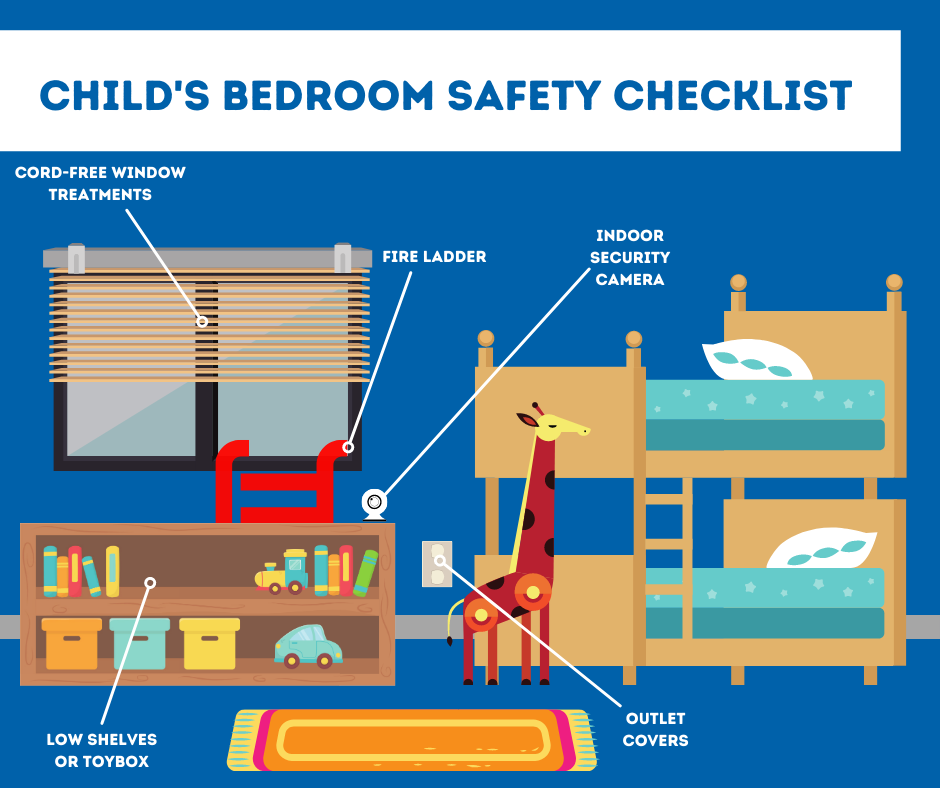
Children’s Bedroom Safety Checklist For State College
Your child’s bedroom should balance safety with manageability. If their window shades or other things are safe but tricky to manage, then your children may perform risky methods -- like climb a dresser -- to use them. Here are 5 simple, and safe, ideas:
-
Cordless Window Coverings: Safety agencies have identified cords from shades and blinds an unsuspecting problem for both children and pets. Use motorized blinds or shades that you can easily open and close with a remote control. Or go state-of-the-art and link your motorized treatments to your security system so they can raise on a schedule when it’s time to get up, and close in the evening for added darkness.
-
Tableside Security Camera: A camera sitting on your toddler’s dresser can behave as an HD baby monitor that you can view from your phone. And if they want you, they can push the 2-way talk feature on the camera.
-
Outlet Covers: While each outlet should use protective covers on them to protect your small children, this is especially important in their bedroom. It’s the main place in your house where your toddler will most likely hang out by themselves without constant adult supervision.
-
Window Escape Ladder: If you use bedrooms on the second floor, then you will want to put in a window fire ladder. These will help a child get out of their room when the hallway or ground floor are on fire. Make sure to rehearse how to use the ladder at least twice a year.
-
Toy Chest Or Low Bookshelves: It’s interesting to look at a toy chest as a safety item, but you’ll understand if you’ve ever stepped on a building block in your bare feet. A clean floor means a quick retreat during a fire or break-in.

Master Bedroom Safety Checklist For State College
The main bedroom should be your calm space, so let your safety components make you more responsive when you have an emergency event. After all, being startled awake by a high-decibel buzzer can be disorienting.
-
Smart Hub Touchscreen: Having a smart hub on your bedside table gives you a sense of what’s going on without getting out of bed. You could alternatively log into your ADT phone app. However, the touchscreen may be easier to manage to use when you’re bleary-eyed and disoriented.
-
Device Charging Stand: We rely on our cell phones for so much now alarm clocks, internet searches, time wasters, and --legend has it-- even phones. But, an uncharged phone will cut us off from communications if something goes wrong. To keep it nice and ready, a an easy-to-use charging station is an essential.
-
Smart Lights Or Nightlights: A tiny light can be a beacon when you’re startled awake from an alarm or other loud sounds. If you won’t drift off to sleep with a small nightlight, install smart bulbs in your bedroom and hall. Then you can have light anytime with a button push or voice command.
-
Fireproof Safe: Store your important papers like social security cards, medical information, or a spare checkbook in a fireproof lockbox. This can be a large one that sits in your closet or a small portable lockbox that you can grab as you escape during an emergency event.
-
Heat Sensor: The problem with most bedrooms is that they tend to run too hot or be chilly because they are far away from the thermostat. A temperature sensor can communicate to your smart thermostat so you can have a nice, peaceful sleep at a wonderful temperature.
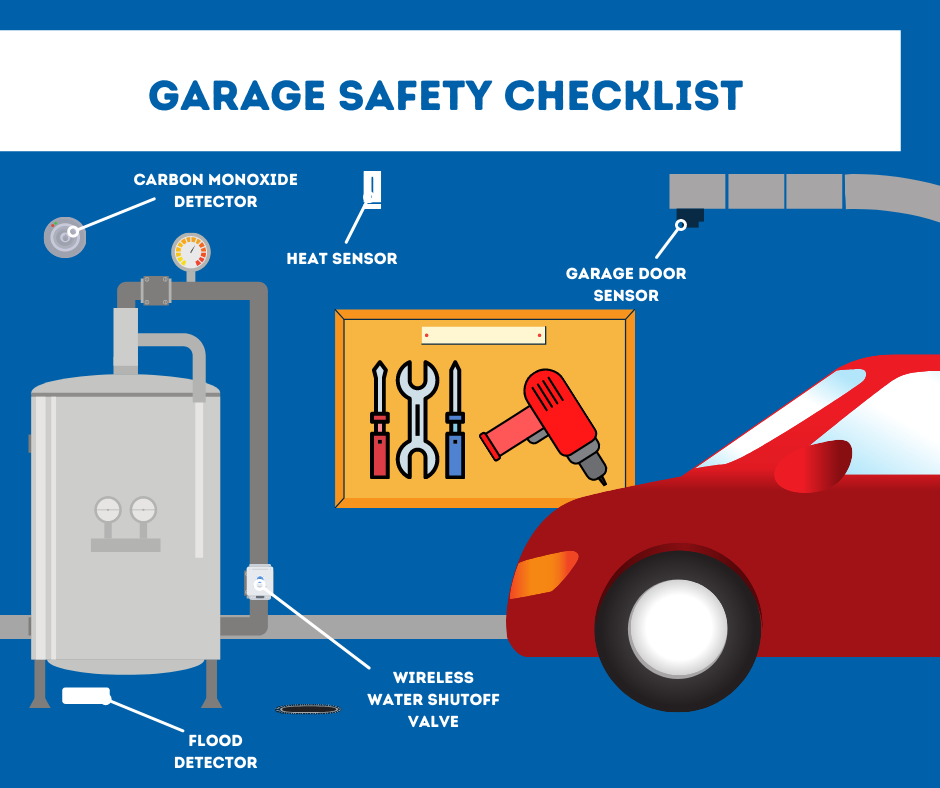
Garage/Basement Safety Checklist For State College
Most safety problems in the garage or basement deal with your water or furnace. Finding issues before they start can stave away larger problems later on. So, as you take a look around your storage areas, pay attention to these safety items:
-
Flood Sensor Or Sump Pump Alarm: Placing a flood sensor by your water heater and sump pump can save you from wading into a pond when you walk into your garage or basement. It’s definitely better than rummaging through a bunch of destroyed storage boxes.
-
CO Alarm: It’s smart to have a carbon monoxide detector in areas where a natural gas leak can happen. If you employ gas heat, try to hang an alarm in the same place as your unit.
-
WiFi Water Shutoff Valve: If your flood detector finds a hot water heater leak or a burst pipe, then you will have to shut off the main water line immediately. With a WiFi shutoff valve, you can turn off your water flow from anywhere in the world. That’s helpful when you’re out of town and receive an emergency leak notification on your mobile device.
-
Garage Door Sensor: Leaving the garage door open brings about all sorts of headaches. You can lose heat or air through that gaping hole, and rodents or thieves can just wander in. A sensor will notify you about a neglected garage door and lets you lower it with your phone.
-
Temperature Sensor: A temperature sensor in your garage or basement is essential if you fret about frozen pipes. The temperature in these rooms can be surprisingly different than your main rooms of the home, so you will need to have a closer eye on the temp with your security mobile app.
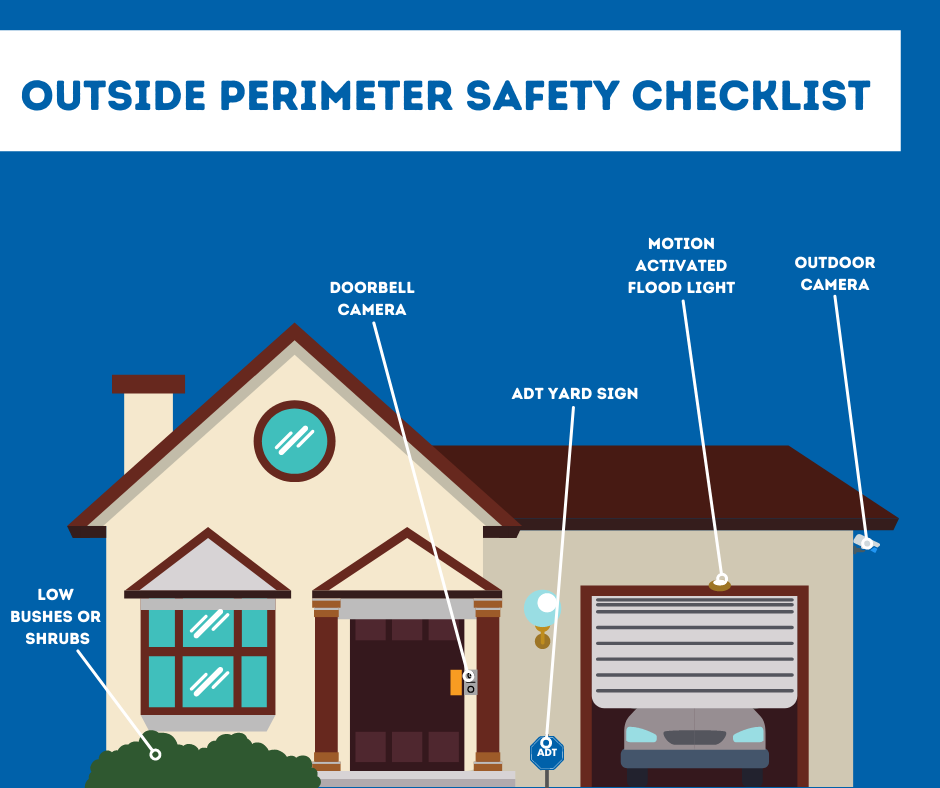
Outside Safety Checklist for State College
Your foliage, driveway, and front step are just as imperative to defend as the interior of your home. Try this checklist to create a safe outside:
-
Doorbell Security Camera: See who’s arrived at the door before you answer it and chat with guests. Get a visual on deliveries and record video clips if they vanish off the step.
-
Outdoor Camera: You can place outdoor cameras to notify you about unusual activity in your yard. These cameras come in handy in places where you may not have a view -- like a side yard or by the garage door.
-
Window Height Shrubs: High foliage can create some privacy, but they also hinder your view of the outside. Don’t provide potential thieves a place to hide. Plus, tall bushes or trees against your house can obstruct gutters and bring in ants and termites.
-
ADT Yard Signs: One of the biggest disincentives for a break-in is advertising to would-be intruders that you have a monitored ADT security system. An ADT yard sign by the front door and a window cling will alert ne'er-do-wells that they might want to keep walking to an less prepared house.
-
Motion Activated Outside Light Fixtures: Light is the best obstacle to people who skulk in the shadows. Motion-activated lighting on your porch, garage, or deck can frighten lurkers away. Flood lights also help you see the walk when you get to the house on those dark, winter nights.
Call Secure24 Alarm Systems To Help You Finish Your Home Safety Checklist for State College
While Secure24 Alarm Systems can’t help you with each household item on your State College home safety checklist, we can offer a state-of-the-art home security. With easy-to-use devices and ADT monitoring, we can personalize the perfect system for your family’s needs. Just call (814) 212-8021 for more information or complete the form below. Or customize your own ADT system with our Security System Designer.
